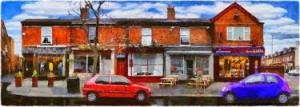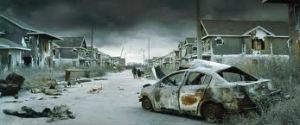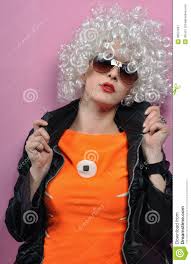It’s been an exciting few weeks. The Kindle version of my novel has been released on Amazon and I’ve been getting reviews. After years spent writing in isolation, getting feedback, good or bad, is a wonderful thing. I can’t tell you how heart warming it is to hear someone talking about characters that have only ever lived in a room in my head.
A few of the reviews have talked about my depiction of Chorlton, the south Manchester suburb where most of the novel is set and where I live. A review in the Manchester Evening News even had the title Annette’s sideways view of Chorlton. Anyway this got me thinking about the role that Chorlton plays in the story and a sense of place in novels in general.

The Relative Harmony of Julie O Hagan is set in Chorlton between 2007 and 2008. Moneyed bohemian types have moved in and gentrified the once ordinary suburb. They wear Birkenstocks, eat hummus and shop locally for eco friendly cleaning products. This contrasts with the world of the main characters, Julie and Billy, a working class couple. He is an Irish immigrant, she was brought up on the local estate and they bought their terraced house before the house prices rocketed. She wears pink velour track suits, they let their kids eat Haribos, they drink boxes of Blossom Hill wine, and nether possesses a bike. Julie and Billy observe the changes around them with scepticism, fascination and envy. The contrast of the two worlds makes for moments of humour but also conflict. This conflict leads them to act and do things they might not have done had they lived elsewhere. In this way the setting has a direct influence on their motivation and narrative.
Some places I have visited in fiction have stayed with me more than others. One is the fictional town of Maycomb in Harper Lee’s To Kill a Mockingbird. Set in the years of the Great Depression, the town’s oppressive poverty, insularity and racially segregated community is wonderfully drawn. When Tom Robinson goes on trial in the courthouse it seems there could never be any verdict other than guilty in such a setting.
Another is the post- apocalyptic world of Cormac MaCarthy’s The Road. Everything is abandoned and covered in grey ash and colour only appears when the boy and his father have flashbacks of their former life.
“Dark of the invisible moon. The nights now only slightly less black. By day the banished sun circles the earth like a grieving mother with a lamp.”
McCarthy’s setting is often seen as as a commentary on a post 9/11 world where mass terrorism, genocide and weapons of mass destruction are real possibilities.

Some might say that without setting there is no story. Samuel Beckett would disagree. I remember spending hours as a student struggling through a couple of his novels that have no setting, fictional or real. Molloy, for example, is made up entirely of the two interior monologues of two characters set in an indeterminate place.
One of the Amazon reviews of my book said, “A knowledge of Manchester is not needed to enjoy the book and relate to the characters as there is a Chorlton in all parts of the country.” I was delighted with this. It suggests that the reader sees Julie and Billy’s predicament is a general one, that there are people all over the country being pushed out of or struggling to live in neighbourhoods where they were brought up because of house prices. And this is something I wanted to get across in the story.
My second novel is also based in Chorlton. I sometimes wonder if I’ve just been lazy and I should have packed up and moved on somewhere else. I admit to taking a swipe at the place but it’s an affectionate swipe. I love Chorlton and I wouldn’t live anywhere else. Besides, it has endless scope for satire. I just hope I don’t end up having to wear a blonde wig and large sunglasses whenever I go out.

